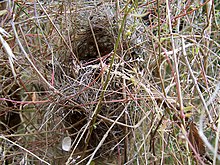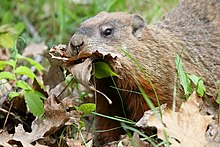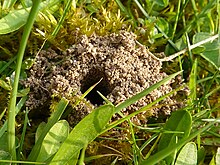Nesting instinct

Nesting behavior refers to an instinct in animals during reproduction to prepare a place with optimal conditions for offspring.[1] The nesting place provides protection against predators and competitors that mean to exploit or kill offspring.[2] It also provides protection against the physical environment.[1]
Nest building is important in family structure[3] and is therefore influenced by different mating behaviours and social settings.[4] It is found in a variety of animals such as birds, fish, mammals, amphibians, and reptiles.[1]
In mammals
Female
Pigs
Under natural conditions,
Rodents


In
Particularly among
Hormones and nesting behavior
Maternal nest-building is regulated by the hormonal actions of estradiol, progesterone, and prolactin. Given the importance of shelter to offspring survival and reproductive success, it is no wonder that a set of common hormonal signals has evolved. However, the exact timing and features of nest building vary among species, depending on endocrine and external factors.
The initial drive to perform this behavior is stimulated internally via hormones, specifically a rise in prolactin levels. This increase is driven by an increase in prostaglandin and a decrease in progesterone.[15] The second phase of nest building is driven by external stimuli, this phase is also known as the material-oriented phase. In this stage it is said that external stimuli such as the proper nest building materials must be present. Both internal and external stimuli must exist in conjunction with one another for nest building to commence. The cessation of the nest building is correlated with a rise in oxytocin which is the hormone responsible for the contraction of the uterus. Shortly after this, parturition will commence.[6]
In
External factors also interact with hormones to influence maternal nest-building behavior. Pregnant rabbits that have been shaved will line their straw nest with available alternatives, such as male rabbit hair or synthetic hair. If given both straw and hair, mothers prefer straw during the straw-carrying period, and prefer hair during the nest-lining period. If given hair as the only material, shaved mothers collect the hair even when it is the straw-carrying period.[19]
In birds
Research on
In fish
In sand goby (Pomatoschistus minutus) the males are the ones who build the nests. When males exhibit increased paternal care to eggs, they build nests with smaller entrances in comparison to males who provide less parental care. This helps prevent predators from entering the nest and consuming the offspring or developing eggs.[7]
In insects

Nesting behavior is also present in many invertebrates. The best known example of nesting behavior in insects is that of the domestic honey bee. Most bees build nests. Solitary bees, like honey bees, make nests. However, solitary bees make individual nests for larvae and are not always in colonies.[21] Solitary bees will burrow into the ground, dead wood and plants.[21][22]
See also
References
- ^ PMID 30805137.
- ISSN 0003-3472.
- ^ S2CID 24496866.
- ^ ISSN 0003-3472.
- ^ PMID 15946732.
- ^ .
- ^ S2CID 53155468.
- PMID 26333669.
- ^ .
- ^ Triunveri, Alfeo (24 May 2012). "Rodents: Habitat, Pathology and Environmental Impact". Animal Science, Issues and Professions: 1–194.
- ^ The Ecological Impact of Animal Nests and Burrows, by M. H. Hansell. Functional Ecology, 1993, Vol. 7, No. 1 (1993), pp. 5–12. Published by The British Ecological Society.
- – via Wiley Online Library.
- ^ "CAB Direct". www.cabdirect.org.
- ^ The Evolution of Marmot Sociality: II. Costs and Benefits of Joint Hibernation, by Walter Arnold. Behavioral Ecology and Sociobiology, 1990, Vol. 27, No. 4 (1990), pp. 239–246. Published by Springer.
- S2CID 9742677.
- S2CID 40974635.
- PMID 5156617.
- PMID 5388889.
- S2CID 25558539.
- JSTOR 27848517.
- ^ a b "Make a Bee Hotel – The Pollinator Garden". www.foxleas.com. Retrieved 2018-11-19.
- ^ "Enhancing Habitat for Bees – The Xerces Society". The Xerces Society. Retrieved 2018-11-19.
